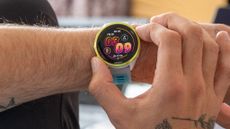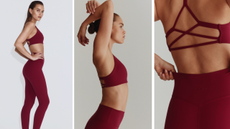Active
The latest Active breaking news, comment, reviews and features from the experts at T3
Explore Active
-

CES just teased the future of e-bikes and it might finally fix range anxiety
Hello Space’s MAG DRIVE system promises pedalling-powered charging without drag
By Matt Kollat Published
-

Jackery’s new ‘Ultra’ power station is built like a tank and finally makes home backup truly portable
The Explorer 1500 Ultra promises extreme durability, fast charging and serious wattage
By Matt Kollat Published
-

This roaming solar robot might be the strangest (and smartest) CES launch I’ve seen this year
Jackery’s Solar Mars Bot looks like a toy, but it’s secretly a roaming home backup system
By Matt Kollat Published
-

AEKE Smart Home Gym review: powerful digital resistance and AI coaching in a fitness mirror
AI real-time coaching and powerful digital resistance mean it’s not just for cardio lovers
By Leon Poultney Published
-

“We’re just building cool gadgets we want to use”: Pebble Round 2 launches as the brand maps a calmer future for wearables
Pebble brings back its iconic round watch while quietly building tools that blend AI, creativity and week-long battery life
By Matt Kollat Published
-

Apple promises easier Fitness+ workouts and better routines in 2026
A fresh set of programs, new music-fuelled workouts and celebrity voices arrive to help users stay consistent this year
By Matt Kollat Published
-

If running isn’t for you, this bodyweight workout is your cardio answer
No running, no kit, no excuses – this workout still boosts your cardio
By Lucy Miller Published
-

The most underrated strength training method is also the fastest
The power of one-set training
By Lucy Miller Published
-

I tried 'posture walking' for a week, and honestly, I feel taller
Why how you walk matters more than how far you go
By Lucy Miller Published
-

Garmin's 'Goldilocks' running watch falls to its lowest ever price
The Forerunner 570 is down to £390.99 – a bargain for such a competent smartwatch!
By Matt Kollat Published
-

Amazfit’s much-hyped budget Garmin rival has built-in music storage and claims three-week battery life
The Active Max looks like a true Forerunner 970 competitor on paper – minus the hefty price tag
By Matt Kollat Published
-

The best Cyber Monday fitness deals: from workout shoes, to fitness trackers and recovery tech
Enhance your training and freshen up your workout wardrobe with these top Cyber Monday deals
By Bryony Firth-Bernard Published
-

H&M Move unveils its new SculptMove Collection to help you feel confident and move better
Expect smooth, sculpting leggings, sports bras, yoga flares and more
By Bryony Firth-Bernard Published
-

Runners often overlook this bodyweight exercise – but I’ve been using it to get faster
A simple plyometric move that builds power, balance and better running economy
By Lucy Miller Published
-

Bored with basic squats? Try these 5 dynamic variations to train your legs in every direction
Don’t let your squats get stale
By Lucy Miller Published
-

Move over, sit-ups – A world-renowned PT says these 4 standing abs exercises are unrivalled for building deep core strength
You won’t need to sit down (or sit up) for this one
By Lucy Miller Published
-

I did a 'resting squat' every day for two minutes – here’s how it improved my mobility, posture and comfort
This underrated move can boost posture, hip mobility, and even digestion
By Lucy Miller Published
-

The workout headphones that read heart rate from your ears have fallen to their lowest price for Boxing Day
Part noise-cancelling headphones, part fitness tracker, the Beats Powerbeats Pro 2 fall to their lowest-ever price for Christmas
By Matt Kollat Published
-

Smart glasses are getting good fast and 2026 could be their make-or-break year
Smart glasses are sleeker, smarter and far more capable than the Google Glass days
By Matt Kollat Published
-

Best Boxing Day Garmin deals – experts select the best buys in the sale
The hottest Garmin deals this Christmas
By Matt Kollat Published
-

I test tech for a living and these six gadgets won me over in 2025
From the world’s first 360º drone to smart earrings, 2025 proved innovation in tech is far from slowing down
By Matt Kollat Published
-

JTX Fitness's pro-grade treadmill that beats NordicTrack on price just got a Boxing Day discount
The JTX Club-Pro receives a tasty price cut – just in time for January
By Matt Kollat Published
-

New Garmin software update just made battery anxiety measurable on the brand's most underrated smartwatch
Latest beta update finally explains where your battery life is going
By Matt Kollat Published
-

I’ve spent years camping and these 3 are the best camping knives I’ve seen this year
The camping knives that actually earned a place in my pack this year
By Derek Adams Published
-

I’ve run over 1,000 miles in 2025 and these are my top three women's running trainers
Winter miles, mixed terrain and a three-shoe rotation that actually works
By Lucy Miller Published
-

We were promised an AI wearable revolution in 2025 – will 2026 finally deliver?
AI wearables two years on
By Matt Kollat Published
-

Best camping mat 2025: inflatable and foam sleeping pads ranked
We select the best camping mats for every occasion, from self-inflating pads to cheap and cheerful roll mats
By Matt Kollat Last updated
-

Can you pause Training Status on your Garmin watch? Yes, you can.
Garmin watches have a hidden 'Christmas mode' for your Training Status
By Matt Kollat Published
-

Best rowing machine 2025 for a full-body workout at home
The best rowing machines to buy today, from top brands including NordicTrack, WaterRower, Hydrow and more
By Bryony Firth-Bernard Last updated
